
You’ve probably seen pictures of frame tents and cabin tents, but are you sure you want one of those? If so, read this article to learn the basics of each type of tent. You can also learn about Geodesic tents and inflatable-tube tents, as well as their pros and cons. Once you’ve made your decision, you’ll be better equipped to decide which tent is right for you. We’ll look at each type in greater detail below or click here for more info.
Frame tents
There are two main types of tents: Pole and Frame tents. Both have their advantages and disadvantages. Pole tents are cheaper than frame tents and are easy to install. While pole tents are generally easier to set up, you will have to make sure that your yard has a perimeter of 10 feet around the tent. Compared to pole tents, frame tents are much more durable and sturdy. The downside is that frame tents take longer to set up. Regardless of what type you choose, they have advantages over pole tents, including being able to install on concrete surfaces.
Frame tents are ideal for smaller events because they are free-standing without interior poles. They can be custom installed over uneven surfaces or over swimming pools. Because they are free-standing, they are also great for use in multiple-tent installations. They come in several sizes and colors, as well as multiple-sidewall options. To customize your frame tent, consider the type of top you want. Whether you want a clear or solid top, or a combination of both, you will find what you need.
Cabin tents
Cabin tents are a great option if you want a comfortable, temporary home. The cabin tent design has separate rooms on either side of the center area. The center area is typically used as living space and the side rooms are bedrooms. The separate rooms are ideal for privacy. However, you should also keep in mind that cabin tents require a lot of effort to set up. They can be difficult to use, especially if you don’t know much about camping.
The Coleman Cabin Tent features a mesh ceiling and windows, as well as upper and ground vents to let hot air escape. This style is best for campgrounds and summer camping. The interior is large enough to fit bunk beds, cots, and airbeds. It also includes a wall organizer to hold small items such as flashlights. A cabin tent has room dividers to separate sleeping areas for privacy. Some models have a removable floor, while others are not.
Inflatable-tube tents
When shopping for an inflatable-tube tent, you should look for features that make them easy to set up. Most tents have top-and-bottom zippers and some have a system for tying the flaps back. Check the fabric for rips and wear. The seams should be even and stitched well. If any aren’t, you should consider purchasing a tent with seam sealant. If you don’t have the time to buy a new one, you can always get a used one for cheap.
Inflatable-tube tents have a sprung frame built into the fabric. They come in a coiled circular package and are typically intended for a brief stay. Because they can be set up quickly, inflatable tents are typically more expensive and made of higher-quality materials than poled tents. In addition, these tents may be heavier than poled tents. To make up for these differences, you’ll want to consider the quality of the tent you’re considering.
Geodesic tents
Developed by R. Buckminister Fuller, the first geodesic tent was commercially available in the early 90s. The design was further developed and perfected by Robert “Bob” Gillis, Mark Erickson, and Bruce Hamilton. In fact, the geodesic tent concept was the genesis of the eponymous fabled’snow house’. Several years later, the Geodesic tent found new life in the hands of commercial manufacturers, including The North Face.
There are several models of geodesic tents available. The Black Diamond Bombshelter is a lightweight but incredibly strong 4-person geodesic tent. The company behind this tent is well-known for their renowned climbers’ gear and takes build quality seriously. It is perfect for small families and teams of four. Another unique feature is the vestibule. This vestibule allows you to store gear outside the tent, and it has a dog door for easy access.
Pup tents
While many people enjoy the outdoors and use pup tents for camping, few of them know their origins. The pup tent is a simple backpacking shelter with several modern adaptations. This article will discuss how this type of shelter was first created and its history. Pup tents have an interesting history, dating back to the Civil War. Listed below are some of its best uses. Listed below are the pros and cons of using this style of backpacking shelter.
The earliest pup tents were designed to provide shelter in rainy weather, but they often disintegrated quickly in harsh conditions. Because of this, troops would prop up the tents with rifles or sturdy tree branches. When the Second World War began, however, the pup tents improved. They now have sturdy pole frames instead of wooden stakes. Mosquito netting is now included with most pup tents. This makes them a better choice for outdoor activities during the rainy season.
